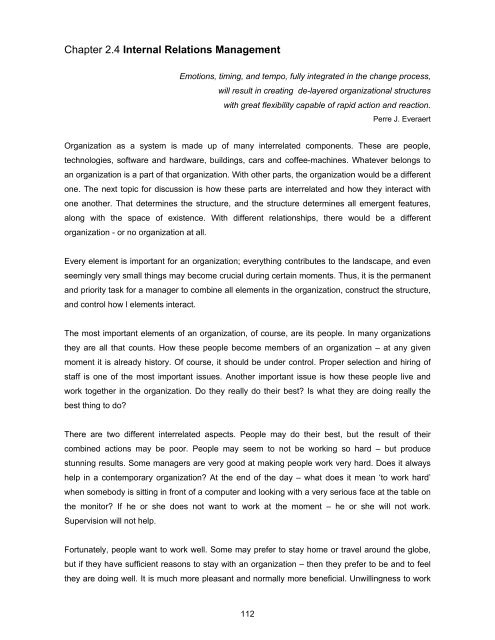Organizational Development: A Manual for Managers and ... - FPDL
Organizational Development: A Manual for Managers and ... - FPDL
Organizational Development: A Manual for Managers and ... - FPDL
You also want an ePaper? Increase the reach of your titles
YUMPU automatically turns print PDFs into web optimized ePapers that Google loves.
Chapter 2.4 Internal Relations Management<br />
Emotions, timing, <strong>and</strong> tempo, fully integrated in the change process,<br />
will result in creating de-layered organizational structures<br />
with great flexibility capable of rapid action <strong>and</strong> reaction.<br />
Perre J. Everaert<br />
Organization as a system is made up of many interrelated components. These are people,<br />
technologies, software <strong>and</strong> hardware, buildings, cars <strong>and</strong> coffee-machines. Whatever belongs to<br />
an organization is a part of that organization. With other parts, the organization would be a different<br />
one. The next topic <strong>for</strong> discussion is how these parts are interrelated <strong>and</strong> how they interact with<br />
one another. That determines the structure, <strong>and</strong> the structure determines all emergent features,<br />
along with the space of existence. With different relationships, there would be a different<br />
organization - or no organization at all.<br />
Every element is important <strong>for</strong> an organization; everything contributes to the l<strong>and</strong>scape, <strong>and</strong> even<br />
seemingly very small things may become crucial during certain moments. Thus, it is the permanent<br />
<strong>and</strong> priority task <strong>for</strong> a manager to combine all elements in the organization, construct the structure,<br />
<strong>and</strong> control how l elements interact.<br />
The most important elements of an organization, of course, are its people. In many organizations<br />
they are all that counts. How these people become members of an organization – at any given<br />
moment it is already history. Of course, it should be under control. Proper selection <strong>and</strong> hiring of<br />
staff is one of the most important issues. Another important issue is how these people live <strong>and</strong><br />
work together in the organization. Do they really do their best? Is what they are doing really the<br />
best thing to do?<br />
There are two different interrelated aspects. People may do their best, but the result of their<br />
combined actions may be poor. People may seem to not be working so hard – but produce<br />
stunning results. Some managers are very good at making people work very hard. Does it always<br />
help in a contemporary organization? At the end of the day – what does it mean ‘to work hard’<br />
when somebody is sitting in front of a computer <strong>and</strong> looking with a very serious face at the table on<br />
the monitor? If he or she does not want to work at the moment – he or she will not work.<br />
Supervision will not help.<br />
Fortunately, people want to work well. Some may prefer to stay home or travel around the globe,<br />
but if they have sufficient reasons to stay with an organization – then they prefer to be <strong>and</strong> to feel<br />
they are doing well. It is much more pleasant <strong>and</strong> normally more beneficial. Unwillingness to work<br />
112
















